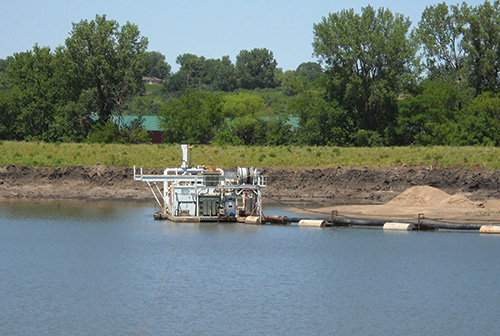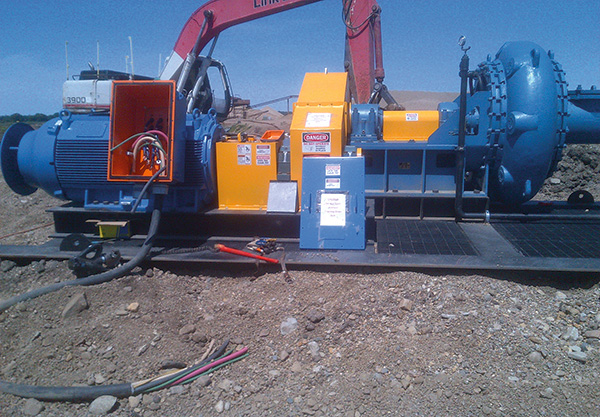Hallett Materials Boonville sand mine is located in the city of West Des Moines, Iowa. West Des Moines is a small rural area located in Dallas County that is known for its historical ties to the Boone family. The area is one of Hallet Materials locations for producing a full line of pure sand and gravel products. Hallet, operating from more than 40 aggregate deposits in central and western Iowa, supplies applications ranging from material fill and filtration, building foundation base, road stone, landscaping stones and pea gravel.
Hallett Materials operates its Boonville Pit in central Iowa to supply sand for both concrete and asphalt. Typical applications include ready mixes, paving projects and rock products for home building and road bases. This plant has been supplying the area continuously with product for more than 12 years. The operation consists of a fixed processing plant, a mobile dredge with one slurry pump and mining and dredging areas.
The original layout of the plant was determined several years ago by the location of the sand and gravel deposits throughout the site. The existing layout consisted of a primary mobile dredge with a 1,000-horsepower, direct-current (DC) motor and variable frequency drive (VFD) coupled to a large slurry pump. This was the only pump that fed the fixed processing plant. The floating pump and dredge was anchored by cables at three separate points to the shore of the pit and was maneuvered with winches along the excavating line. The pump suction was then used to move the sand/gravel/water slurry from the lake pit through a flexible pipe to the plant for final processing and distribution.
 A VFD and harmonic filter were assembled on a custom moveable skid so they could be placed close to the booster pump as it
A VFD and harmonic filter were assembled on a custom moveable skid so they could be placed close to the booster pump as itDuring the last few years, as the most productive areas of the sand pit became farther and farther away from the existing pumping dredge, the production life of the pit was in jeopardy. The existing dredge could only pump up to 1,800 feet from the plant, but many areas farther away still needed to be mined. The problem was that the range of the existing equipment and layout of the site prevented any expansion into these new areas.
The plant’s engineering team determined that a solution might be to install a booster pump that would be placed between the primary pumping dredge and the processing plant. Since the maximum distance of the new mining areas was 2,500 feet from the existing processing plant, the booster pump would need to be sized to handle the heavy slurry material efficiently from that distance. It also had to be placed at least 1,000 to 1,200 feet from the existing processing plant between the plant and the existing dredge. A suitable peninsular area that had already been mined was chosen as a location for the booster pump and additional drive equipment. Also, all components needed to be completely contained and mounted on two movable skids.
After studying these criteria, the Hallet team determined that a booster pump using an 800-horsepower, alternating-current (AC) motor and variable speed drive would efficiently drive and control the slurry pump. Hallet Materials consulted an electric motor company for help. The key criteria for the new booster pumping station would be that it had to be efficient, electric and extremely quiet because of the close proximity of residential neighborhoods. The company’s latest version of its 800-horsepower motor was chosen because of its high reliability and low maintenance. In similar installations, this motor provided a wide speed range, low weight to output ratio, high capacity to dynamic loads and low noise level.
In addition to the booster pump, the electric motor company provided a medium-voltage drive, power transformer and harmonic filter, which were needed for the installation to be matched for optimum efficiency. All this equipment was mounted on a separate skid, allowing it to be located on the peninsula along with the pump skid.
After determining the specifications of all the equipment required, the company designed and constructed custom cabinets and enclosures to house these additional components and mounted them on the second skid. Matching all these components was critical in achieving the highest efficiency output and lowest electrical usage. The medium-voltage drive was selected because of its modular design and its 99 percent efficiency record in many similar applications.
 The 800-horsepower, AC motor and slurry pump were assembled on a custom skid, allowing for an extended mining area.
The 800-horsepower, AC motor and slurry pump were assembled on a custom skid, allowing for an extended mining area.Since the plants’ licensing requirements dictated that the operation cannot operate more than 8 to 10 hours per day, the production output capacity was a critical component of the solutions. The new booster pump motor and drive installation has far exceeded the production target by doubling the original output to 400 to 500 tons per hour.
The addition of the booster pump and drive skids now allows Booneville to extend its production area within the site and double its production per hour. The slurry is now pumped from the existing dredge to this new booster station that sits on a peninsula in the middle of the property, which then pumps the sand/rock/water slurry to the processing plant. This completed installation is a good example of how to maximize the life and double the output of a pumping operation with minimal effort. It is also a good example of the benefits of partnerships between producers and original equipment manufacturers.


